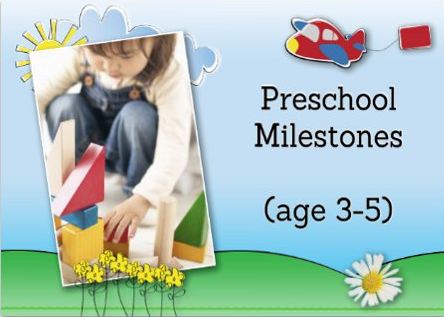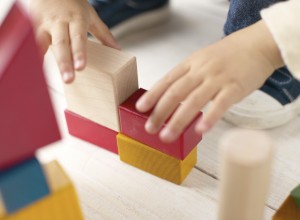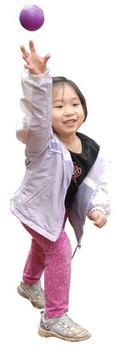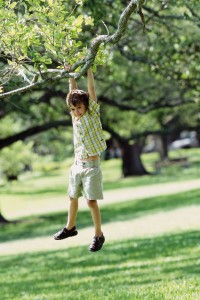Last updated on May 28th, 2024 at 11:26 am

We talked about your baby’s first year of milestones, as well as why they are important here. As your children continue to grow, it’s good to keep an eye on their milestones for several important reasons.
With general milestones, you are made aware of what tasks to start letting and teaching your kids do. I know sometimes as parents we can be so used to doing something for a child that we need a reminder to really start challenging their skills, allowing them to live up to reasonable expectations. I know my son (age 3) reminds me repeatedly that he wants to be a big boy and do new things all by himself.
Preschool-aged children start to learn pre-academic skills that will benefit them though their entire school career. If a genuine delay or difficulty presents itself, it’s best to address it early and properly. This will benefit the child in the long run so that learning can be fun instead of discouraging.
*Remember that each child is different, and that just because he or she is not meeting some of the milestones does not mean you should be alarmed. Any concerns should be mentioned to your child’s physician or preschool teacher.
Below is a categorized list of things your child should be doing between the ages of three to four and four to five.
Age 3-4
Adaptive (Self-Help Skills):
- Dresses with assistance
- Undressed without assistance
- Unfasten Buttons
- Puts shoes on (though not always on the correct feet)
- Toilet trains
- Washes and dries hands without some supervision
- Brushes teeth with supervision
- Uses a spoon and fork with little spilling
- Pours liquid into a cup
- Spreads soft foods with table knife
- Wipes nose and mouth when prompted
- Says name, age and gender

Cognitive (Learning, Thinking, Problem-Solving)/ Pre-academic
- Can work toys with buttons, levers, and moving parts
- Plays make-believe with dolls, animals, and people
- Follows three part commands (take off shoes, wash hands, sit at table)
- Matches shapes, colors, objects and pictures
- Groups objects and pictures by attribute (e.g. color, shape, size)
- Counts to 10
- Names 6 basic colors
- Identifies 6 body parts
- Recites word from familiar songs or nursery rhymes
- Shows interest in books, turning pages and looking at pictures
- Attends to short stories being read
- Demonstrates visual memory recall (was there a lion on the page or an elephant?)
- Can recognize letters
Fine Motor Skills (Using Small Muscle Groups to Maneuver Body):
- Builds 3 block bridge after it’s modeled for them
- Builds 8-10 block tower
- Scribbles within a designated area
- Holds a crayon with fingers instead of fist
- Copies drawing lines, circles and a cross
- Strings beads
- Places pegs in and out of a board
- Completes 5-6 piece puzzles
- Cuts across paper
- Rolls, pats and pinches play-dough

Gross Motor Development (Using Large Muscle Groups to Maneuver Body):
- Safely maneuvers though environments while walking and running
- Pedals a tricycle
- Walks up and down stairs while holding rail alternating feet going up
- Balances on one foot for one second
- Throws a ball overhand
- Catches a bounced ball
- Jumps off low steps or objects landing on both feet
- Walks on a line on the floor
- Safely climbs low playground equipment
- Kicks a stationary ball
- Runs with some falling
Social and Emotional:
- Enjoys doing new things
- Plays “Mom” and “Dad”
- Is more and more creative with make-believe play
- Would rather play with other children than by themself
- Cooperates with other children
- Often can’t tell what’s real and what’s make-believe
- Talks about what they like and what they are interested in
AGE 4-5
Adaptive:
- Can use the toilet independently
- Puts shoes on right feet and may be able to tie shoes
- Knows clothing front from back
- Brushes teeth independently
- Dresses and undressed without assistance
Cognitive/Language (Learning, Thinking, Problem-Solving):
- Speaks very clearly
- Tells a simple story using full sentences
- Understands and uses time concepts like yesterday, today, and tomorrow
- Understands size concepts like bigger, smaller, less, more
- Says name and address
- Counts 10 or more things
- Can draw a person with at least 6 body parts
- Knows about things used every day, like money and food
Fine Motor Development:
- Uses all feeding utensils properly
- Properly grasps a pencil
- Can print some letters or numbers
- Copies a triangle and other geometric shapes
- Cuts out simple shapes with scissors

Gross Motor Development:
- Stands on one foot for 10 seconds or longer
- Hops; may be able to skip
- Can do a somersault
- Swings and climbs
- Tests their physical limits and performing “tricks” like standing on head (may be a daredevil)
Social and Emotional:
- Wants to please friends
- Wants to be like friends
- Seeks adult approval and more likely to agree with rules
- Likes to sing, dance, and act
- Notices other feelings
- Is aware of gender
- Can tell what’s real and what’s make-believe
- Shows more independence
- Likes to make own decisions (giving choices is appropriate at this stage)
- Is sometimes demanding and sometimes very cooperative
*More details can be found on development milestones as well as printouts at CDC.gov. This list is adapted from the CDC.






